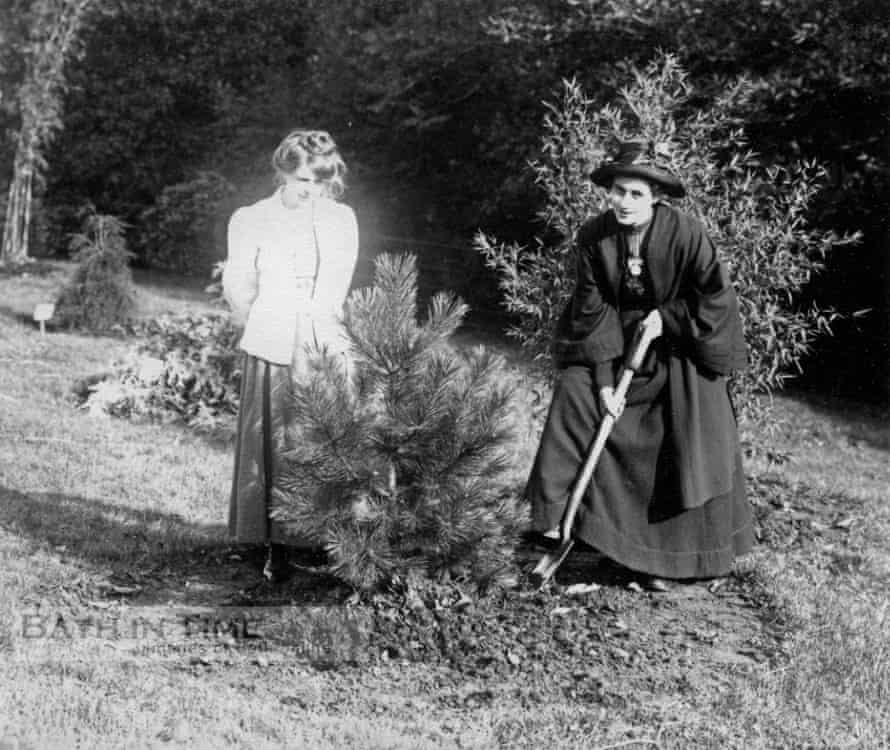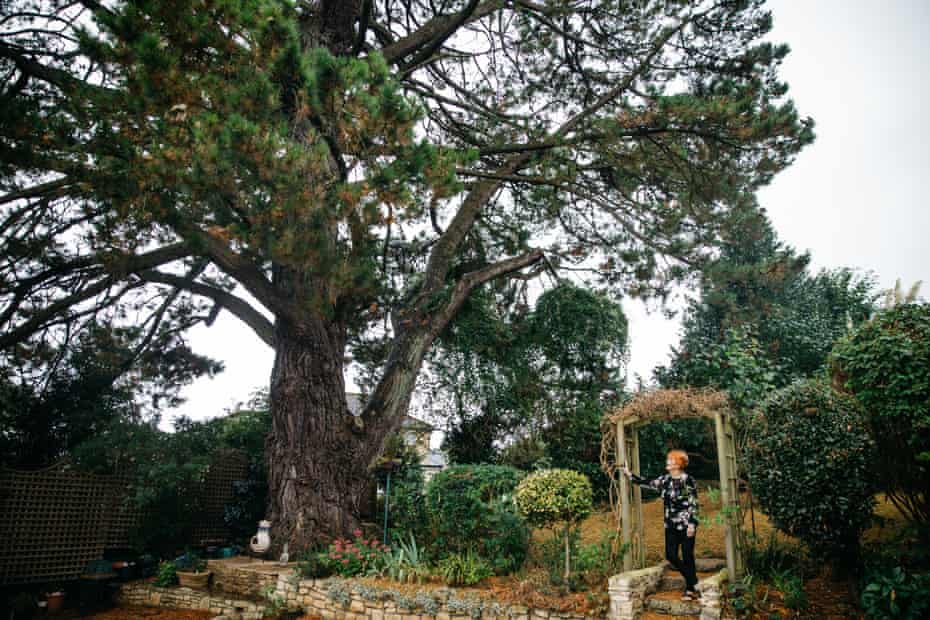Legacy of a lost pine: the suffragettes’ tree inspiring a new generation

A century ago, women activists planted an arboretum outside Bath. Only one tree survived – now it’s generating seeds for a new woodland and a new cause
In a sunny back garden north-east of Bath stands a 30-metre pine tree. Its widespread branches are home to squirrels, magpies and nuthatches, and in late summer it sheds its needles to thatch the lawn below. The tree has seen enormous political and social change over its 100-year lifespan and, if the women who come to visit it have a say, has yet to see a lot more.
When midwife Eileen Paddock moved to Batheaston village 43 years ago, her two young boys wasted no time climbing the tree in their new home. But she knew nothing about its history until a Canadian professor of art history got in touch three decades later.
Dr Cynthia Hammond of Concordia University had long been fascinated by Bath but wanted to dig deeper into its feminist and activist history. Having discovered an “amazing collection of historic photographs” of women planting trees in the city, she set out to find out more, at one point offering potted evergreen plants to locals in exchange for information.
A response finally came from an 89-year-old woman called Mary Frayling, who had lived in the area her whole life. Hammond discovered that the Batheaston black pine had been planted in 1909 by a suffragette, Rose Lamartine Yates, on the land of nearby Eagle House. The house was then owned by the Blathwayt family, who were sympathetic to the women’s liberation movement and opened their doors to campaigners from across the country.
Many found solace in gardening, and planted trees on the house’s extensive grounds, which became known as the suffragette’s wood, or Annie’s Arboretum, after the working-class campaigner Annie Kenney.

At least 47 trees were planted: holly to celebrate women working for the right to vote and conifers for the more militant women who had been imprisoned. Yates planted her pine sapling after being arrested while lobbying parliament for the right to vote.
Although it was an important destination for suffragettes and suffragists at the height of the liberation struggle, Annie’s Arboretum was destroyed in the 60s to make way for housing; the Batheaston pine was the only tree to survive. “Mary and her brother dashed in ahead of the bulldozers to save the little plaques that had been put in the ground next to each of the trees saying which suffragette the tree had been planted for,” says Hammond.
Hammond co-produced a booklet about the arboretum to accompany a local exhibition in 2011 and continues to make regular pilgrimages to see Bath, Paddock and the pine tree.
She is not the only visitor. Until the pandemic struck, a group of artists and environmentalists held an annual vigil at Batheaston, where they would sing songs, reconnect and reflect beneath the tree’s protective canopy.
Shelley Castle, Anne-Marie Culhane, Lucy Neal and Ruth Ben-Tovim met through Encounters, a Devon-based participatory arts project, around the centenary of the suffragette movement in 2018 and immediately hit it off.
“One of the questions that came up was: ‘If the suffragettes were around today, what would they be standing up for?’ We thought that might be climate justice, alongside social justice, which of course are intertwined,” says visual artist Castle.
Having learned about Annie’s Arboretum, Castle found herself under a pine tree in Batheaston on a very hot summer’s day. “I heard the sound of pine cones cracking and realised they’re releasing seeds. I thought: ‘What if these seeds are viable?'”

It turned out that they were. The women have propagated seeds from Yates’ pine – a tricky task – and have half a dozen healthy saplings in their care. As part of a decade-long Walking Forest project, which combines art, environmentalism and feminism, they hope to plant an “intentional woodland” similar to Annie’s Arboretum by 2028 to celebrate women who stand up for and protect the natural world.
“I’m really interested in how we go back to the past in order to ground the present to look to the future,” says Ben-Tovim, an artist with a theatre background who helped instigate Culture Declares Emergency. “The whole idea of the intentional woodland is a bit like the arboretum; yes it was a place where those trees were planted but it was clearly also a location that the suffragettes went to for rest, for recuperation.”
The group has also ceremonially given seeds from Yates’ pine to inspire people involved in environmental change. These include climate lawyer Farhana Yamin, Stop Ecocide Foundation chair Jojo Mehta, and delegates at the UN climate talks in Katowice, Poland, in 2018, such as Patricia Espinosa – now executive secretary of the UN framework convention on climate change. They plan to do something similar at the Cop26 climate conference in Glasgow in November.
“A Cop is this neon-lit massive conference centre – all the plants are plastic potted,” says theatre-maker and writer Neal. “And just by bringing this small seed with that story of a tree planted by a woman fighting for change over 100 years ago has had a quiet, extraordinary impact on every single person that we came across.”
Another pillar of Walking Forest is taking root this autumn, as the group runs a workshop for women in Coventry as part of this year’s city of culture. Ben-Tovim says the aim is to give women from a variety of backgrounds a creative space to reflect and express what is important to them.

As part of this, a group of women will be carrying a felled tree through the streets of Coventry.
“Through Walking Forest we’re weaving together some of our own interests around the public realm,” says Ben-Tovim. “For me, a lot of it is how do we find a voice to articulate and stand up as women for what matters to us, for who we are?”
Walking Forest is also part of a new interdisciplinary study with the universities of Bangor and Birmingham that examines how trees hold cultural memory. It is funded by the UK research councils’ Treescapes grant, which aims to make the nation’s tree stocks more resilient.
Throughout it all, Yates’ black pine continues to wield a metaphorical and physical power.

Artist and activist Culhane, whose work deals with environmental themes, says finding out about the arboretum was “a brilliant moment … and then also this heartbreak realising that it had all been bulldozed, that it was completely disregarded”.
She stresses that when women’s rights activists planted Annie’s Arboretum in the early 1900s, they did not know whether their campaigning would bear fruit. “The moment when they’re putting these seeds in the ground, there is a completely uncertain future that they’re just imagining; it was four or five years before they even saw a glimmer of getting the vote.
“I feel like, those of us now that can see the realities of our times, the dire circumstances that we’re in unless we make some radical changes, might feel the same as they did.”
Although the pandemic put a halt to the group’s visits to Batheaston, they are hoping to meet under the black pine again soon. Paddock, who has now retired as a midwife, will be joining them and has got a tree preservation order to protect the pine.
“It’s not my tree,” she says. “It’s everybody’s tree. I’m just looking after it, like I would a baby.”
Find more age of extinction coverage here, and follow biodiversity reporters Phoebe Weston and Patrick Greenfield on Twitter for all the latest news and features
